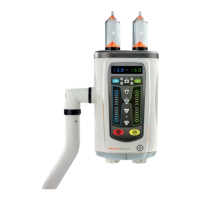
Do you have a question about the Bayer HealthCare CERTEGRA MEDRAD Stellant FLEX and is the answer not in the manual?
| Device Type | Contrast Delivery System |
|---|---|
| Pressure Limit | 325 psi |
| Power Requirements | 100-240V AC, 50/60Hz |
| Display | Touchscreen LCD |
| Power Source | AC Power |
| Application | CT Imaging |
| Number of Syringes | Dual |
| Syringe Capacity | 200 ml |
| Flow Rate Range | 0.1 - 10 ml/sec |
| Connectivity | Ethernet |
| Injection Protocols | Programmable |
| Type | Injector System |
The primary manual detailing the operation of the system.
Device certifications and compliance standards.
Description of the intended user patient group.
Specifies the intended medical applications for the device.
Lists conditions where the device should not be used.
Information on legal restrictions for device sale.
Details the necessary training for operating the device.
Bayer's liability and user responsibilities.
Explanation of the EPC for electrical bonding.
Instructions or contact for system installation.
Explains standard safety and informational symbols.
Identifies system controls and graphical elements.
Critical safety information regarding potential injury or death.
Information about potential minor injury or moderate harm.
Information regarding potential equipment damage.
Visual representation of system components and connections.
Fundamental principles of fluid injection.
Describes features aiding syringe loading.
Explanation of how to set injection parameters.
Overview of optional informatics features.
Guidelines for using the system's support structure.
Description of the main operational interface.
Details of the workstation's controls and displays.
Controls located on the injector head unit.
Description of the parts comprising the injector head.
Function and operation of the hand-held control.
Configuring overall system settings.
Configuration for Personalized Patient Protocol Technology.
Managing and organizing injection protocols.
Configuring fluid delivery system parameters.
Setting up data management and connectivity.
Accessing the system's help resources.
Managing contrast media settings.
Understanding error signals from the injector head.
Displayed messages and codes for system errors.
Additional guidance for resolving common issues.
Explanation of auditory alerts and signals.
Procedures for cleaning spills.
Daily cleaning and disinfection routines.
Daily inspection and cleaning procedures.
Monthly maintenance checks and procedures.
Annual maintenance and calibration tasks.
Instructions for moving and setting up the system.
Various ways to physically install the system.
Cables for extending injector head reach.
Cables for extending workstation reach.
List of available system add-ons.
Other documentation related to the system.
List of single-use items.
Technical details of the workstation.
Technical details for workstations with pods.
Technical details of the base unit.
Technical details of the injector head.
Operating and storage conditions.
Safety features against incorrect fluid delivery.
Performance metrics related to fluid delivery.
Details about the power cable requirements.
Security measures for network and data.
Information about the system's fuse.
Steps to turn on the injection system.
Procedures for safely turning off the system.
Steps to recover from injector shutdown.
How to define and modify injection protocols.
Process for saving created or edited protocols.
Steps to load previously saved protocols.
Managing protocols with simultaneous contrast and saline delivery.
Tasks performed in the control room before injection.
Tasks performed in the scan room before injection.
Notification for insufficient fluid volume.
Steps to prepare the injector for injection.
How to start the fluid injection process.
Pausing the injection manually.
Information on what happens when an injection is stopped.
Monitoring the status of an ongoing injection.
How to see system-generated alerts.
What occurs when an injection finishes successfully.
Screen displayed when an injection is prematurely stopped.
Procedures after the injection completion screen.
Configuring overall system settings.
Configuration for Personalized Patient Protocol Technology.
Managing and organizing injection protocols.
Configuring fluid delivery system parameters.
Setting up data management and connectivity.
Accessing the system's help resources.
Managing contrast media settings.
Understanding error signals from the injector head.
Displayed messages and codes for system errors.
Additional guidance for resolving common issues.
Explanation of auditory alerts and signals.
Procedures for cleaning spills.
Daily cleaning and disinfection routines.
Daily inspection and cleaning procedures.
Monthly maintenance checks and procedures.
Annual maintenance and calibration tasks.
Instructions for moving and setting up the system.
Various ways to physically install the system.
Cables for extending injector head reach.
Cables for extending workstation reach.
List of available system add-ons.
Other documentation related to the system.
List of single-use items.
Technical details of the workstation.
Technical details for workstations with pods.
Technical details of the base unit.
Technical details of the injector head.
Operating and storage conditions.
Safety features against incorrect fluid delivery.
Performance metrics related to fluid delivery.
Details about the power cable requirements.
Security measures for network and data.
Information about the system's fuse.